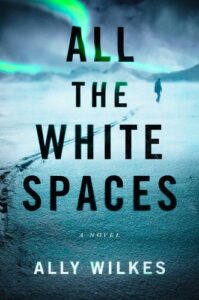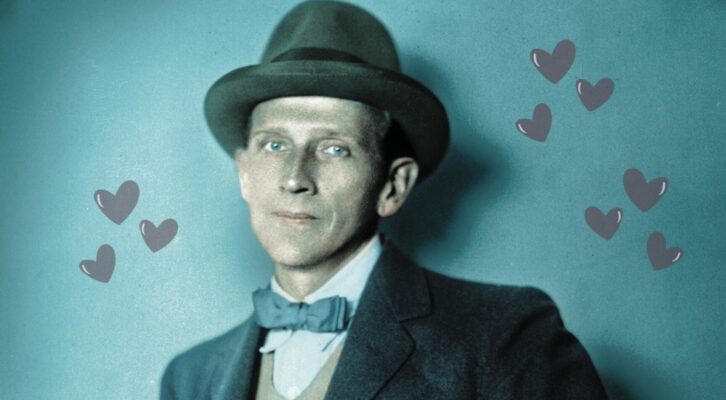I’m never really sure whether I believe in ghosts. Despite growing up in some seriously spooky and remote old houses, I’ve never actually seen anything: no figures in white sheets, no women in suspiciously generic period costume. However, particularly when alone, I’ve felt—well, something. The sense of a presence. The idea that you’re not actually alone; that something unseen is with you. Other people, of course, might experience this as the presence of the divine. But for me, it was always something supernatural.
My debut novel, All The White Spaces, deals with a fictional expedition to Antarctica in the years immediately after the First World War. I chose to write about this setting due to a near-lifetime obsession with the so-called ‘Heroic Age’ of exploration, and the exploits of Scott, Shackleton, and other famous explorers who ‘went South’ to risk their lives in the name of discovery. Once I started to read accounts associated with these early expeditions, I was struck by how eerie they made Antarctica sound—despite the fact that the writers were your typical late Edwardian ‘stiff upper lip’ gentlemen, many described supernatural or other disturbing encounters with something which sometimes seemed to be native to Antarctica itself.
The first type of encounter (and most famous) is that of the ‘third man’. People in extremis have often encountered the sense of a watchful and benevolent or helpful individual accompanying them through dangerous situations. John Geiger’s The Third Man Factor: Surviving the Impossible[1] is a comprehensive overview of the topic, collecting accounts from long-distance sailors, shipwreck survivors, mountaineers, miners—and Polar explorers. The phenomenon is named for the experience of Ernest Shackleton and his two companions while crossing the mountainous interior of South Georgia island in 1916. They were the only people alive who knew that their shipmates were waiting for rescue, following the loss of their ship Endurance in the treacherous ice of the Weddell Sea, and their journey to find help—at the whaling station across the mountain ranges—involved scant rations, no sleep, crevasses, giant ice ridges, steep drops, and a near-total lack of equipment.
Shackleton’s account of this journey in his book South ends with the mysterious observation that: “When I look back at those days I have no doubt that Providence guided us… I know that during that long and racking march of thirty-six hours over the unnamed mountains and glaciers of South Georgia it seemed to me often that we were four, not three.”[2] This sensation was one he shared with his companions when they had reached safety: each had independently experienced the same sense that they had been accompanied by an invisible companion. The story later made its way into TS Eliot’s 1922 poem The Waste Land:
Who is the third who walks always beside you?
When I count, there are only you and I together
But when I look ahead up the white road
There is always another one walking beside you.
This, then, was my introduction to the idea that I was in good (even illustrious!) company having felt an unseen presence— and that Antarctic exploration might naturally lend itself to a spooky, supernatural type of story, even with very matter-of-fact narrators. This was only heightened by examining the extraordinary photographs which Frank Hurley took on the Endurance expedition (and which, remarkably, made it through that sinking of the ship). The ones which I found most intriguing juxtaposed jagged, white, endless ice fields with a single human figure—shown, perhaps, for perspective. The figure is entirely in silhouette, faceless, utterly out of keeping with the silent landscape around him. It’s hard to view them and not be struck by the eeriness of the image: a sense of presence made visible and tangible.
The benevolent third man—which John Geiger dubs the ‘saviour’ presence—appears to be something distinct from our traditional understanding of ghosts. It appears in crisis situations and interacts with the observer, even if only to provide a sense of comfort. However, the Antarctic also contains stories of encounters with a less benevolent presence. This second type of encounter, again, doesn’t fit neatly into the category of ‘ghost’, if by that we mean the spirit of a human person who has died (and often at the place in question—Antarctica poses a bit of a conundrum on this front, as although it’s certainly seen its share of deaths, its footprint of human occupation is far later and far sparser than most other places on the planet).
The story which chilled me (quite literally) took place on Sir Ranulph Fiennes’ Transglobe expedition in 1980, at the foot of Ryvingen Mountain, where four members set up base camp to wait out the Antarctic winter. The team’s radio operator was the formidable Virginia, Lady Fiennes (‘Ginny’) who spent countless hours in the radio hut, over fifty metres from the team’s main living quarters. She told her husband: “There’s something there,” and spoke of an unsettling entity or presence which—on occasion—followed her when she left the hut. When another team flew in to dismantle the base, one newcomer described it as “an empty hut with an aura… I sealed it up as I knew I would not want to go back up there.” Ginny had apparently scratched graffiti into its walls about the ‘ghost of Ryvingen’:
Why have you come to disturb me
After these many years
I will haunt and will taunt you
And drive you away.[3]
This same sense of presence was also described by men overwintering at the Argentine Antarctic base of Esperanza, and in similar terms: always felt in the most isolated structures, usually at night, and amounting to “a strong sensation of being observed” (although others, troublingly, reported seeing a male figure).[4]
Worse, perhaps, Fiennes described his wife hearing things: crying in the darkness, and someone “whispering indistinguishable words from close behind her”. Brrr—and, I was to discover, not so different at all from what was sometimes experienced by other Polar explorers.
Shackleton’s The Heart of the Antarctic[5] opens with a teasing allusion to what might be termed the third type of Polar supernatural encounter: he attributes the urge to go out into the “void spaces of the world” to the “‘lure of little voices’, the mysterious fascination of the unknown.” I found this idea—of someone being tempted out into the wilderness by unseen voices—so creepy that it formed the kernel of All The White Spaces, and the Shackleton quotation is my novel’s epigraph. The poem it refers to (The Lure of Little Voices by Robert Service) is even creepier still:
Yes, they’re wanting me, they’re haunting me, the awful lonely places;
They’re whining and they’re whimpering as if each had a soul;
They’re calling from the wilderness, the vast and God-like spaces,
The stark and sullen solitudes that sentinel the Pole.
While there’s never any acknowledgment that these ‘little voices’ are anything other than figurative, I felt they had their parallels in two experiences described by Apsley Cherry-Garrard, one of the youngest members on Scott’s tragic 1912 expedition to the South Pole. The setting for each experience was an expeditionary hut, in itself something to conjure with: these man-made structures were built over a hundred years ago, and have been effectively frozen in time. Those who come across them describe having a powerful sense that the occupants have merely stepped out into the snow and will be back shortly, with books left open and provisions left half-eaten. This was Cherry-Garrard’s impression when coming across the abandoned Cape Royds hut, which he described as: “dismal. I expect to see people coming in through the door after a walk over the surrounding hills.”
Later that night, however, Cherry-Garrard describes hearing voices:
The whole place is very eerie, there is such a feeling of life about it. Not only do I feel it but the others do also. Last night after I turned in I could have sworn that I heard people shouting to each other. I thought that I had only got an attack of nerves but Campbell asked me if I had heard any shouting, for he had certainly done so. It must have been the seals calling to each other, but it certainly did sound most human…
It might have been seals, or it might have been the stress and strain of an unusual environment – Cherry-Garrard admitted that “we are getting… worked up”. But towards the end of their time in the Antarctic, he once again experienced the same type of incident as they lay awake waiting in that haunted atmosphere for their companions to return:
Last night we had turned in about two hours when five or six knocks were hit on the little window over our heads… Someone one lit a candle… and we all rushed out. But there was no-one there. It was the nearest approach to ghost work that I have ever heard.[6]
They put this incident down to a dog wagging its tail in its sleep, hitting the window. Two very sensible explanations – not to mention the emotional forces which must have been working on them! I was entranced, though, by the idea of these huts as haunted spaces, which was only reinforced by Sir Edmund Hilary’s famous encounter at that same Cape Royds hut. The conqueror of Everest had been born three years after Shackleton’s death, but recognised him instantly: “I’m not a person who really sees things very much but when I opened the door I distinctly saw Shackleton walking towards me and welcoming me.”[7]
The final type of encounter with mysterious forces in the Antarctic, however, was even harder to categorise: these were accounts in which the landscape or the elements themselves appeared to be unfriendly. You might say this is unsurprising— after all, it is Antarctica—but many descriptions dwelled on the idea that there was an animus or hostility directed specifically at explorers seeking to penetrate its mysteries. On Shackleton’s 1908 push towards the Pole over the Great Ice Barrier, he seemed to feel an almost spiritual sense of unease: “It is as though we were truly at the world’s end, and were bursting in on the birthplace of the clouds and the nesting-home of the four winds, and one has a feeling that we mortals are being watched with a jealous eye by the forces of nature.” This feeling grew until (when they were forced to give up and turn back to save their own lives) Shackleton felt he was rebuffed by the landscape itself on the return journey. Falling into a hidden crevasse at the last moment, he felt that “it seemed as though the glacier were saying: “There is the last touch of you; don’t you come up here again.”
What are we to make of all these encounters with the supernatural in Antarctica? Geiger’s book explores a number of explanations for these experiences, including the obvious debunking favorites: cold, stress, fatigue, dehydration, near-starvation and the ability of the bored and desperate human mind to project onto the great white blank sheet of Polar ice— to make patterns, and seek company, where none is to be had. This explains, for example, why so many encounters with the ‘third man’ are helpful, consoling, comforting experiences. I was also deeply intrigued by the explanation put forward for those encounters at the Esperanza base, which features in a 1986 study by psychologist Jane Mocellin: all took place within the powerful electrical field of the station generator, and the base itself was located near a strong local magnetic anomaly.[8]
However, what activated my horror-writer mind was the idea that these might not be benign presences at all: that Shackleton’s “jealous eye” of nature existed alongside Cherry-Garrard’s account of strange noises which caused them to rush out of the safety of their base and into the snow and night; that, like Ginny Fiennes’ ghost of Ryvingen, something wanted to “haunt and taunt” the explorers. And, while I might have sensed presences in eerie old houses, the idea that there’s something there—how much scarier would it be to experience that in Antarctica, in the perpetual night, with no ability to leave?
Antarctica as haunted house: now there’s an idea.
[1]John Geiger, The Third Man Factor: Surviving The Impossible, Canongate Books 2010
[2]Ernest Shackleton, South: The Endurance Expedition, Penguin Books 2002
[3]Ranulph Fiennes, To The Ends of the Earth, Hodder & Stoughton 1983
[4]John Geiger, The Third Man Factor: Surviving The Impossible, Canongate Books 2010
[5]Ernest Shackleton, The Heart of the Antarctic, William Heinemann 1910
[6]Apsley Cherry-Garrard, The Worst Journey In The World, Constable & Co 1922
[7]New Zealand Herald, Conqueror of Everest says he saw Shackleton’s ghost, 23 January 2005
[8]John Geiger, The Third Man Factor: Surviving The Impossible, Canongate Books 2010
***

















